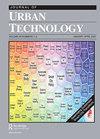Urban and Infrastructural Rhythms and the Politics of Temporal Alignment
IF 4.6
3区 经济学
Q1 URBAN STUDIES
引用次数: 5
Abstract
ABSTRACT To date, urban research has paid little attention to the role of urban infrastructures in shaping and ordering urban temporalities. I contend that the study of infrastructures offers a powerful lens for understanding the reciprocal relationship changing infrastructural and urban temporalities as well as the power-driven processes of temporal alignment and realignment. Approaching time through the empirical study of infrastructures, I argue, reveals how contemporary infrastructural change is entangled with—often conflicting—orientations to the past, present, and future. At the same time, it uncovers how temporal ordering and reordering processes by socio-technical systems not merely reflect, but also enable, constrain, and preconfigure contemporary and future urbanism. Specifically, periods of infrastructural change, crisis, and failure reveal various temporalities, asynchronisms, and misalignments that are otherwise invisible or neglected but are crucial for the broader understanding of urban change and its governance.城市和基础设施节奏和时间排列的政治
迄今为止,城市研究很少关注城市基础设施在塑造和排序城市时间性中的作用。我认为,对基础设施的研究为理解不断变化的基础设施和城市时间性的相互关系以及时间对齐和重新调整的权力驱动过程提供了一个强有力的视角。我认为,通过对基础设施的实证研究来接近时间,揭示了当代基础设施的变化是如何与过去、现在和未来的取向纠缠在一起的——往往是相互冲突的。同时,它揭示了社会技术系统的时间排序和重新排序过程不仅反映了当代和未来的城市主义,而且还实现、约束和预先配置。具体来说,基础设施变革、危机和失败的时期揭示了各种不可见或被忽视的时间性、异步性和错位,但这些对于更广泛地理解城市变化及其治理至关重要。
本文章由计算机程序翻译,如有差异,请以英文原文为准。
求助全文
约1分钟内获得全文
求助全文
来源期刊

Journal of Urban Technology
URBAN STUDIES-
CiteScore
8.50
自引率
4.20%
发文量
42
期刊介绍:
The Journal of Urban Technology publishes articles that review and analyze developments in urban technologies as well as articles that study the history and the political, economic, environmental, social, esthetic, and ethical effects of those technologies. The goal of the journal is, through education and discussion, to maximize the positive and minimize the adverse effects of technology on cities. The journal"s mission is to open a conversation between specialists and non-specialists (or among practitioners of different specialities) and is designed for both scholars and a general audience whose businesses, occupations, professions, or studies require that they become aware of the effects of new technologies on urban environments.
 求助内容:
求助内容: 应助结果提醒方式:
应助结果提醒方式:


